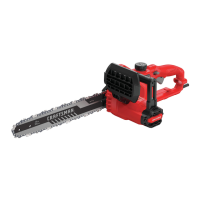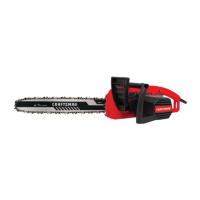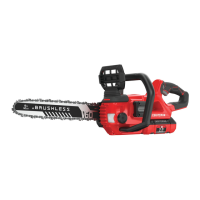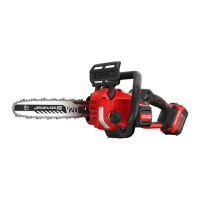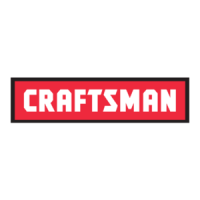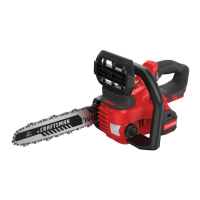7
ENGLISH
GENERAL SAFETY RULES
DANGER: Shock Hazard. Serious injury or death
from electrocution if power lines are contacted. Never
use near any electrical source, wires, or powerlines.
WARNING: For safe operation read and
understand owner’s manual. Wear face shield
(and/or safety glasses) and hard hat to protect
against falling debris. Always have a clear work area,
retreat path, and be aware of limb/branch location to
avoid falling limbs and debris. Keep bystanders 50 ft
(15 m) away when operating saw. To reduce the risk
of electric shock do not use on wet surfaces. Do not
expose to rain. Storeindoors.
• To protect yourself from falling branches do not stand directly
under the branch or limb being cut. This unit should not be
held at an angle over
60°
from groundlevel.
• Keep the handles dry, clean, and free ofoil.
• Before you start the unit, make sure the chain is not contacting
anyobject.
• Make sure the cutting chain has stopped before setting the
unitdown.
Guard Against Kickback
WARNING: KICKBACK may occur when the nose or
tip of the guide bar touches an object, or when the
wood closes in and pinches the saw chain in the cut.
Tip contact in some cases may cause a lightning
fast reverse reaction, kicking the guide bar up and
back towards the operator. Pinching the saw chain
along the top of the guide bar may push the guide
bar rapidly back towards the operator. Either of these
reactions may cause you to lose control of the saw
which could result in serious injury touser.
The following precautions should be followed to
minimize kickback:
• Grip pole saw firmly. Hold the saw firmly with both hands
when the unit is running. Use a firm grip with thumbs and
fingers encircling the saw handle andpole.
• Do notoverreach.
• Keep proper footing and balance at alltimes.
• Don’t let the nose of the guide bar contact a log, branch,
ground or otherobstruction.
• Do not extend pole saw handle above shoulderheight.
• Use devices such as reduced kickback chain, chain braking
system and special guide bars that reduce the risks
associated withkickback.
• Only use replacement bars and chains specified by the
manufacturer or theequivalent.
• Never let the moving chain contact any object at the tip of
the guidebar.
• Keep the working area free from obstructions such as
other trees, branches, rocks, fences, stumps, etc. Eliminate
or avoid any obstruction that your saw chain could hit
while you are cutting through a particular log orbranch.
• Keep your saw chain sharp and properly tensioned. A loose
or dull chain can increase the chance of kickback. Check
tension at regular intervals with the motor stopped and
power supplydisconnected.
• Begin and continue cutting only with the chain moving at
full speed. If the chain is moving at a slower speed, there is
a greater chance for kickback tooccur.
• Cut one branch at atime.
• Use extreme caution when re-entering a previous cut.
Engage spiked bumpers into wood and allow chain to
reach full speed before proceeding withcut.
• Do not attempt plunge cuts or borecuts.
• Watch for shifting branches or other forces that could
close a cut and pinch or fall intochain.
Pole Saw Names and Terms
• Drive Sprocket or Sprocket - The toothed part that
drives the sawchain.
• Guide Bar - A solid railed structure that supports and
guides the sawchain.
• Guide Bar Scabbard - Enclosure fitted over guide bar to
prevent tooth contact when saw is not inuse.
• Kickback - The backward or upward motion, or both
of the guide bar occurring when the saw chain near the
nose of the top area of the guide bar contacts any object
such as a log or branch, or when the wood closes in and
pinches the saw chain in thecut.
• Reduced Kickback Chain - A chain that complies
with the kickback performance requirements of ANSI
B175.1–2012. (when tested on a representative sample
ofchainsaws.
• Reduced Kickback Guide Bar - A guide bar which has
been demonstrated to reduce kickbacksignificantly.
• Replacement Saw Chain - A chain that complies with
kickback performance requirements of ANSI B175.1–2012.
when tested with specific chainsaws. It may not meet
the ANSI performance requirements when used with
othersaws.
• Saw Chain - A loop of chain having cutting teeth, that
cut the wood, and that is driven by the motor and is
supported by the guidebar.
• Spiked Bumper (Spike) - The pointed tooth or teeth for
use when pruning to pivot the saw and maintain position
whilesawing.
• Switch - A device that when operated will complete
or interrupt an electrical power circuit to the motor of
thechainsaw.
• Switch Lockout - A movable stop that prevents
the unintentional operation of the switch until
manuallyactuated.
• Trimming (Pruning) - Process of cutting limbs from
atree.
• Undercut - An upward cut from underside of a log or
limb. This is done while in normal cutting position and
cutting with top of guidebar.
